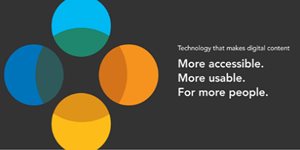AudioEye Helps CivicPlus Build Web Accessibility Into its CMS
AudioEye, makes software that enables every enterprise, from corporations to government  agencies, to make their content more consumable through technology. They recently announced a strategic partnership with CivicPlus, the premier integrated technology platform dedicated to serving local governments. The partnership between CivicPlus and AudioEye will offer the CivicPlus design and development teams informative guidance supplied through Web Content Accessibility Guidelines (WCAG) 2.0 while enabling them to leverage an arsenal of proprietary automated testing, remediation, and compliance monitoring technologies. AudioEye will also make available subject matter experts and engineers to CivicPlus accessibility stakeholders as they ensure accessibility is built into the award-winning CivicPlus CivicEngage content management system (CMS).
agencies, to make their content more consumable through technology. They recently announced a strategic partnership with CivicPlus, the premier integrated technology platform dedicated to serving local governments. The partnership between CivicPlus and AudioEye will offer the CivicPlus design and development teams informative guidance supplied through Web Content Accessibility Guidelines (WCAG) 2.0 while enabling them to leverage an arsenal of proprietary automated testing, remediation, and compliance monitoring technologies. AudioEye will also make available subject matter experts and engineers to CivicPlus accessibility stakeholders as they ensure accessibility is built into the award-winning CivicPlus CivicEngage content management system (CMS).
Before diving into why this partnership goes beyond two technology organizations making an agreement, I’d like to take a moment to explain a little bit about what these two organizations do. Based in Manhattan, Kansas and founded in 1997, CivicPlus currently serves more than 2,500 clients, managing the online representation of municipalities to more than 55,000 government employees and interacting with more than 60 million citizens. The organization has been included on the GovTech100 list since inception, and their clients have been honored with more than 290 top website awards, in the past four years alone. "For more than 20 years, CivicPlus has, exclusively, focused on working with local governments. We understand and appreciate our customers' financial constraints. As financial stewards on their behalf, it is our responsibility to find the most efficient and cost-effective solution to achieve and maintain accessibility," said Sascha Ohler, CivicPlus Vice President of Research and Development.
AudioEye is a provider of a technology platform that monitors sites as they grow, automatically fixing issues to ensure accessibility to individuals using a range of assistive technology. A comprehensive set of tools that AudioEye provides enables digital content providers to create experiences that are more accessible, and more usable, for more people.
Since CivicPlus will leverage AudioEye for continuous testing and monitoring across, potentially, thousands of existing client sites to ensure issues of accessibility are quickly identified and resolved, the premise of this integration is to allow local governments to benefit from the partnership in implementation and pricing; the process is streamlined and seamless for them with all the benefits of fully accessible sites to ensure they continually conform with ADA-related digital accessibility requirements.
Why Is Website Accessibility Imperative?
The population of those with visual, auditory, physical, speech, cognitive, neurological and other disabilities can’t afford to be overlooked. As a matter of fact, in the U.S, one out of every five adults has a disability, according to the Centers for Disease Control and Prevention. Some 15% of the world's population, an estimated 1 billion people, have disabilities. The disability market represents an annual disposable income of $544 Billion in the U.S. alone. When friends and family are included, this adds another $3.9 Trillion, according to the data from The Global Economics of Disability Report (Fifth Quadrant Analytics). A Microsoft study conducted by Forrester Research, Inc. suggests 75% of people with disabilities, more than 39 Million people, use computers today. With all these figures in mind, creating an inclusive and accessible society for all, in both a real and virtual world and prohibiting discrimination on the basis of disability are not good enough motivation for you to make your website accessible, there are also two other main reasons to do so.
Legal Obligations
Nearly a decade ago, the regulations (Title II and III of the Americans with Disabilities Act  (ADA)) were introduced in an effort to remove barriers to creating an inclusive and accessible society for all. The focus of the legislation requirements were initially in places of public accommodation, however, over time, the scope expanded from the physical aspects of accommodation into their digital presence, and that’s where things have gotten complicated as for any organization that receives federal funding or does business with the government, the act requires agencies to make their electronic and information technology accessible to people with disabilities by complying with the ADA Standards. It was told that all federal agencies and companies with whom they do business must be compliant with these rules no later than January 2018. However, on July 20, 2017, Trump Administration’s first Unified Agenda was issued and put the Department of Justice’s rulemakings under Titles II and III of the ADA for websites, medical equipment, and furniture of public accommodations and state and local governments under a category called “2017 Inactive Actions”, which encompasses regulations that have not been formally withdrawn but have no known place in the agency’s planned rulemaking, meaning there will be no regulations about public accommodations or state and local government websites for the foreseeable future.
(ADA)) were introduced in an effort to remove barriers to creating an inclusive and accessible society for all. The focus of the legislation requirements were initially in places of public accommodation, however, over time, the scope expanded from the physical aspects of accommodation into their digital presence, and that’s where things have gotten complicated as for any organization that receives federal funding or does business with the government, the act requires agencies to make their electronic and information technology accessible to people with disabilities by complying with the ADA Standards. It was told that all federal agencies and companies with whom they do business must be compliant with these rules no later than January 2018. However, on July 20, 2017, Trump Administration’s first Unified Agenda was issued and put the Department of Justice’s rulemakings under Titles II and III of the ADA for websites, medical equipment, and furniture of public accommodations and state and local governments under a category called “2017 Inactive Actions”, which encompasses regulations that have not been formally withdrawn but have no known place in the agency’s planned rulemaking, meaning there will be no regulations about public accommodations or state and local government websites for the foreseeable future.
The absence of website accessibility regulations doesn’t stop the complaints filed against non-compliant organizations and businesses. On the contrary, lawsuits and demand letters filed and sent on behalf of individuals with disabilities alleging that the websites of thousands of  public accommodations are not accessible are on the rise. According to court papers, in New York, for instance, 14 retailers including big names like Shake Shack, Nordstrom and Katz’s Delicatessen have been sued in the first 13 days of July.
public accommodations are not accessible are on the rise. According to court papers, in New York, for instance, 14 retailers including big names like Shake Shack, Nordstrom and Katz’s Delicatessen have been sued in the first 13 days of July.
Restaurants are almost leading the pack when it comes to the businesses that people with disabilities sue which makes sense. When you think about blind people, they most likely prefer to consume prepared food rather than cooking, and if restaurants do not have an accessible website for them to browse their menus and order food, what option is left? Users with visual impairments often use screen readers that read a site’s content to them aloud and navigating through a site’s content using one of these tools can be cumbersome and tedious. Therefore, digital businesses should test their design with screen readers. Additionally, proper use of headers and subheadings can help screen readers and search engines understand how information is outlined in the page.
Even the most well-meaning brand leaders and site designers have too narrow a view of what constitutes a disability, said Todd Bankofier, the CEO of AudioEye. He also pointed out an important fact by saying that not only is it people who are blind, deaf, or use wheelchairs, it’s also people with autism, PTSD, visual impairment, epilepsy, dyslexia or colorblindness and all have different needs for digital access. Flashing or strobing images presented on a site, for instance, can trigger seizures in some people. Therefore, the Web Content Accessibility Guidelines (WCAG) 2.0. aims to make online content accessible to:
-
Deafness and loss of auditory capacity
-
Limited visual acuity and blindness
-
Cognitive medical conditions
-
Learning disabilities
-
Speech disabilities
-
Movement-based limitations
-
Photosensitivity
-
Other types of disabilities which impede content consumption
Judges are generally siding with plaintiffs by forcing the business and organizations to make their sites ADA compliant. U.S. District Judge Robert Scola, for instance, has recently ruled that Winn-Dixie’s website was a “place of a public accommodation” under the ADA and issued injunctive relief and awarded attorneys’ fees. The injunctive relief included a requirement that Winn-Dixie would adopt and implement a website accessibility policy that ensures its website conforms to the WCAG 2.0 criteria and, further, that any third-party vendors who interact with the website also must conform to such criteria, according to the Bureau of Internet Accessibility’s website.
Many large enterprises including, Hard Rock Café International, Bed Bath & Beyond Inc., DSW Inc., The Home Depot, Inc., Jos. A. Bank Clothiers, Inc., Forever 21 Inc., Tommy Hilfiger Licensing, LLC, J.C. Penney Company, KMART Holding Corp and many others have also faced legal action due to alleged ADA non-compliance.
Not only The United States but also other countries have started taking legislative action to address accessibility issues. While Canada, for instance, has a set of standards for their government websites, the UK has standards for all "web products", which goes beyond just government websites.
Don’t Leave Money on the Table
The inability to access websites puts not only individuals but also businesses at a great disadvantage. In an interview, Bankofier touched upon the business side of the matter by saying: “Strong, compassionate leaders who are concerned about their ROI are interested in getting everybody the best experience possible when they visit a site." He also reminded us that it is not just for customers: "Your employees use intra-company sites to work, to learn, to succeed, and they need accessible sites, too." I couldn’t agree more with him as usability and user experience are catalysts to a consumer’s decision journey. However, today, as many as half of the websites are nearly impossible for people with disabilities to browse. Considering the number of people with a disability or age-related limitation is expected to increase, the opportunity lies therein for businesses that aim at expanding their audience and reach.
My POV
One of the starting points of making your website accessible to everyone is to audit your current sites. Depending on the intensity of content, it may take too much time when it is done manually. That’s where software like AudioEye comes into play. Additionally, if the process of conducting a Web accessibility assessment through an automated solution may validate your site against accessibility guidelines even more thoroughly when its combined with some manual testing by technology experts. By saying manual testing, I, certainly, don’t mean all the domains and pages but a small number of Web pages in each domain or major area of your website or websites.
Despite the fact that the Trump Administration put the ADA website accessibility regulations on the inactive list that makes no regulations about public accommodations or state and local government websites for the foreseeable future, it is still promising to hear good news like the partnership between CivicPlus and AudioEye or Facebook employing a team of thinkers dedicated to ensuring their platform is accessible to everyone and prohibiting discrimination on the basis of disability. This issue will come to light more and more in the near future. As Jeffrey Wieland, Head of Accessibility Engineering & Operations at Facebook, beautifully puts in; we need “to build empathy into our engineering."

Venus Tamturk
Venus is the Media Reporter for CMS-Connected, with one of her tasks to write thorough articles by creating the most up-to-date and engaging content using B2B digital marketing. She enjoys increasing brand equity and conversion through the strategic use of social media channels and integrated media marketing plans.